
|

|
Viking Age Arms and Armor
Viking Helmets
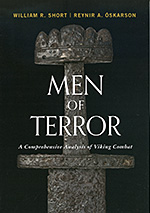 |
Much of the text presented on this page is out-of-date. Until we find time to make the needed updates to this page, we strongly encourage readers to look at this topic as it is presented in our new book, Men of Terror, available now from your favorite book seller. |
During the Viking age, helmets were typically fairly simple: a bowl with a prominent nose guard, as shown in the photo of a reproduction helmet to the right. Contrary to popular belief, there is little evidence that Viking-age helmets ever had horns.
|
 |
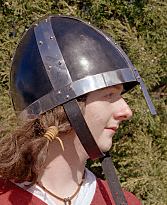 |
The spangenhelm used a single iron band that circled the head around the brow, riveted to two more iron bands that crossed at the top of the head. The four openings were filled with riveted iron plates (right) to create the bowl. In some cases, hard leather may have been used to fill the four openings, rather than iron, to reduce cost, as seen in the replica shown to the left. The nose guard was riveted to the brow. At first glance, the nose guard looks awkward and nearly useless, but I can attest to its usefulness; it's prevented my nose from being broken at least once. |
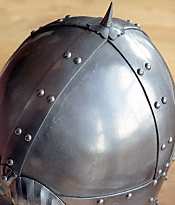 |
It's not clear what was used inside the helmet. Something is needed to lift the helmet up off the head and to spread out and absorb the force of a blow. If the iron of the helmet rested directly on the skull, a blow to the helmet would be transmitted directly to the skull, providing limited protection. A few surviving helmets (and pieces of helmets) have rivet holes which suggest that some sort of leather suspension system was used. In addition, it's likely that a cap made from an absorbent material such as sheepskin was used, not only to absorb the blow, but also to absorb sweat, in order to help prevent the helmet from rusting from the inside.
The sagas suggest that powerful blows with a weapon could penetrate a helmet. In chapter 27 of Egils saga, Keld-˙lfr, in a wild battle frenzy, swung his bryntr÷ll (mail troll, an unknown weapon which probably had an axe-like head) at Hallvarr. The weapon passed through Hallvar's helmet and skull, sinking up to the shaft. Keld-˙lfr pulled the weapon back with such force that Hallvarr was lifted up by his head into the air and tossed overboard.
Harbeinn thrust with his atgeirr, and the point passed through Ůorsteinn's helmet and into his forehead, giving him a serious wound, as is told in chapter 64 of LaxdŠla saga.
Even a sword could penetrate a helmet when wielded by a powerful combatant. In chapter 9 of Gunnars saga Keldugn˙psfÝfls, Gunnar hewed at Írn's helmet with his sword, splitting the helmet and Írn's skull all the way through. Ůorsteinn struck at B˙i's head and cut through B˙i's nose guard to give B˙i a terrible wound, as told in chapter 41 of Ëlßfs saga Tryggvasonar. A blow to the head which didn't penetrate the helmet could still be a useful attack, since the blow would likely disorient an opponent, making a follow-up attack much easier.
There is some evidence in the sagas that suggests that combatants expected their sword to cut through a helmet. In chapter 32 of Finnboga saga ramma, J÷kull struck at ŮorgrÝm's helmet with his sword, but the sword cut no deeper than if it had been made of wood. This surprised J÷kull greatly, since he apparently expected his sword to slice right through the helmet.
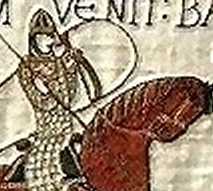 |
Some form of chin fastening is required. Without it, the helmet simply falls off in a fight. Unfortunately, there's little evidence for chin straps. There's no convincing archaeological evidence and little pictorial evidence (although the rider from the Bayeux tapestry shown to the left might arguably have a chin strap). On the other hand, helmets both before and after the Viking age routinely used chin straps. From Grßgßs, the medieval Icelandic lawbook, we know that some people wore hats with chin straps, since there are laws regarding them. |
However, the most convincing evidence for me is that without one, a reproduction helmet is quite useless in a fight; it simply falls off. Some reproduction helmets use a simple thin leather thong that ties under the chin. Speaking as someone with a full beard, I don't find that approach viable. The leather thong is constantly tugging at my beard. The reproduction helmets shown in the photos have wider chin straps. When properly adjusted, they hold the helmet securely without pulling on my beard all the time.
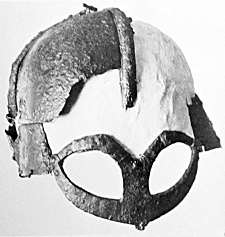 |
Other styles of helmets have been found. The well known helmet (left) found at Gjermundbu in Norway has a spectacle-like covering for the face. A modern reproduction with a similar style is shown to the right. The spectacle style is somewhat frightening both for someone on the outside looking in, and for someone on the inside looking out. From the outside, it presents a frightening visage to the opponent, since the face is covered and made anonymous. But it's even more scary from the inside, since the spectacles catch incoming spear tips and sword points and guide them right into the wearer's eyes. A near miss is converted into a "bullseye" by the eye openings. |
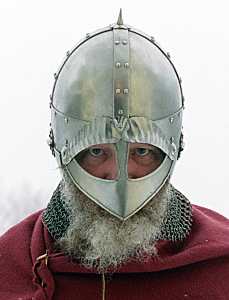 |
Yet the Gjermundbu helmet has clear evidence of battle damage (a sword blow and an arrow puncture), suggesting it was used in earnest fights. So either the Viking age fighters who used these helmets didn't perceive any additional risk from the spectacle guard, or the additional risk was thought to be worth the benefits offered by the spectacle guard.
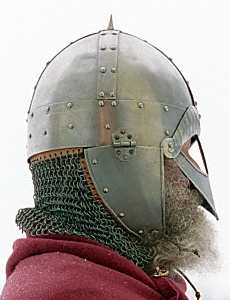 |
Some helmets from the period had mail curtains or solid plates to provide additional protection. The reproduction helmet shown to the left has mail on the neck and solid cheek plates. These defenses provide significant protection against cuts to vulnerable parts of the head and neck. Other forms of solid cheek and neck protection may have been used as well. The additional helmet defenses might not have been helpful in every case. Chapter 40 of Grettis saga tells of Grettir's fight with SnŠkollr, a berserk. SnŠkollr wore a helmet with the cheek-guards undone. Grettir walked up to SnŠkollr, who sat on his horse and immediately kicked the bottom of SnŠkoll's shield up into his mouth, ripping open SnŠkoll's face. Grettir grabbed SnŠkoll's helmet with his left hand and pulled him from his horse while cutting off SnŠkoll's head with the sax in his right hand. Although the saga author doesn't specify where Grettir grabbed the helmet, those loose, dangling check-guards would have made a convenient handle. Even without cheek-guards, a helmet can be used to manipulate an opponent's head to control him (right). A speculative reconstruction of this move is shown in this combat demo video, part of a longer fight. The Gjermundbu helmet has a spike at the crest. Although it's not visible in the photograph of the historical artifact above, the spike is similar to that of the reproduction helmet shown here. The spike turns a simple head butt into a nasty piece of work. |
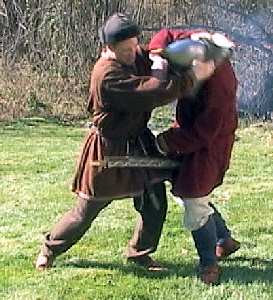 |
The modern helmet reproductions I've used have been comfortable for all-day wear. They weigh about 4lbs (a bit less than 2kg), although some of the larger helmets (with mail and additional protection) may have weighed more than 4kg (10lb). In the Viking era, fighting men probably wore their helmets all day.
|
The classic example from the sagas of a fighter killed before he could put on his helmet occurs in Brennu-Njßls saga (chapter 92). Ůrßinn and his men, while traveling across the frozen Markarfljˇt river (shown to the right as it appears today), saw an imminent ambush from Njßl's sons (who were lying in wait on RauuskrÝur, the hill on the far side of the river). Inexplicably, Ůrßinn took off his helmet and cloak. Before he could put his helmet back on, SkarphÚinn Njßlsson seized the initiative and slid across the ice to drive an axe though Ůrßin's skull. |
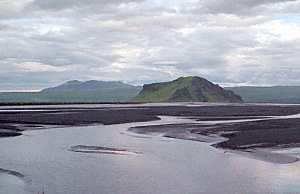 |
The stories suggest that helmets were marked in some manner before a large battle so combatants on each side could identify one another. In chapter 142 of Brennu-Njßls saga, the two sides made ready for the battle at the Al■ing, arming themselves and putting marks (herkuml) on their helmets. However, we don't know what the nature of the markings might have been.
Because iron was difficult to make during the Viking era, it was expensive. As a result, helmets were expensive and thus not common. Anyone who could afford one would certainly want one, but not too many people could afford one. Helmets were prized and carefully preserved, repaired as needed, and passed from generation to generation. Some may well have been used for centuries before the iron became too thin and weak to provide any real protection.
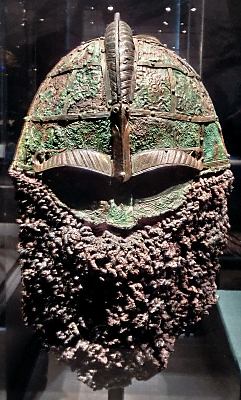 |
Few Viking helmets have survived. The Gjermundbu helmet shown above is the only more-or-less complete Viking-age helmet from the Viking lands. Most Viking helmets survive only as fragments. There are, however, surviving helmets contemporary with the Vikings found in lands to the east, as well as helmets from Scandinavia that substantially predate the Viking age, such as the 7th century Valsgńrde helmet shown to the left. |
|
|
<< Previous article |
Back to Arms and Armor |
Next article >> |
|
ę1999-2026 William R. Short |